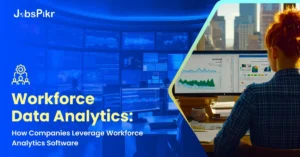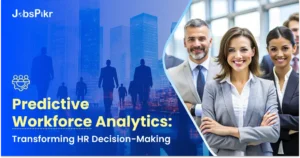You might have already heard about workforce analysis but do you know what it is? When used strategically, workforce analysis helps human resources to plan for their future capabilities.
So, what is workforce analysis?
Workforce analysis is a process using ROI and employee data to make decisions about retention, retirements, and employee management. Performing a workforce analysis helps in maintaining staffing levels to ensure crucial competencies are fulfilled, the cost is optimized, and resiliency is maintained. These are reachable objectives when demand and supply of the skills and employees are singled out and predicted on time.
Impact of Workforce Analysis on HR Department
Workforce analytic has a great impact on the ability of the HR department to hire the right people.
- Evidence-Based Recruiting Decisions: Modern-day HR departments benefit from predictive analytics by eliminating the prospective misfits early on. Using recruitment analysis helps in making the recruitment process more effective. Moreover, it takes less effort and time for the HR department to recruit the right candidate.
- Proactive Strategy: With workforce analytics, the HR department gains critical insights into strategy formulation, ROI, and measured operational outcomes. It leads to a combination of having a retrospective insight to decide the continuous operational and strategic shifts to find the best talent and being proactive about the talent needs of the future.
- Driving Business Strategy: As time goes by, the HR department becomes more proactive and drives employee experience. It shares trends and insights with the prime decision-makers of the industry. For demonstrating value operations to your organization, it is crucial to collect data and use it to help the business.
- Growth: If you don’t know where you came from how it is possible to understand where you would like to go. With workforce analysis, you will have the resources and tools to come up with a plan. This keeps you from repeating the same mistakes. Thus, your organization remains accountable and honest, and you can make prudent decisions.
Best Practice to Conquer the Workforce Planning Process

For some organizations, the workforce is the biggest expense on the income statement that is why staffing and hiring decisions have to be approached carefully. Taking into account the organization and its future, you need to ensure that workforce planning is done right. So, here are some of the best practices for the workforce planning process.
1. Get Insight into the Current Workforce
Getting a comprehensive idea about the future and current state of the headcount isn’t easy because of the data’s dynamic nature. Individuals are going to get hired and their roles are going to change. Thus, if you are using manual spreadsheets, it might be difficult to maintain and the data might be out-of-date when you are done with the analysis.
Moreover, the HRMS system might not have the required data. To come up with an effective decision, you need more information. Without proper data, it might not be possible to plan and form a dependable workforce. For HRs, having an idea about the headcount KPI is a great benefit.
2. Integrate Workforce Analysis with Business Strategy
Integrating workforce planning where HR, finance, and other departments are sharing a single source of data is powerful with a recruiting and hiring plan. In case it is done on the spreadsheets, there can be confusion. Not having direct links from the analysis of workforce gap to the decided hiring procedures, and to have a certain headcount plan for the HRs, it might become difficult to keep the stakeholders updated about who should be hired and when.
But with integrated workforce planning, this problem can be mitigated. The HRs can plan the workforce by aligning with the business plans. So, you have a dynamic and effective business plan that is aligned with the strategic business goals. Ultimately, a proper plan will help out the managers from different departments shift from tactical to strategic workforce planning. It helps in hiring the right people and putting them at the right place at the right time.
3. A Consistent Workforce Planning Process
To be successful, workforce planning and analysis have to be consistent. Simply because you have formed a strategy and implemented it doesn’t mean your work is all done. Some companies fail as they work out an annual plan, instead of updating it regularly.
But your workforce is going to change with time, irrespective of what you are doing. New people are going to join, while some are going to leave, retire, or get promoted. Other factors, such as demographic, economic factors, and competitive factors can affect workforce planning. You have to make an effort to record these changes. When you do this, it helps with the decision-making process. For instance, you will know who is the best fit for a particular job role.
Employee hiring managers need to keep track of their teams and report the financial details every few months or weeks. When the ground is done, it is crucial to update the plans regularly. For maximum efficiency share the workloads and stay updated with the business goals.
4. Tap into the Power of Situation Planning and Analysis
No matter the type of organization you have, it is crucial that you plan out the primary changes, such as acquisition or office expansion. You should be able to react to the transition in the market conditions. With a situation plan, financial leaders, as well as HRs of the company can model a what-if situation depending on a variety of potential results. Workforce situation planning includes fathoming the long-term hiring implications or modeling the immediate requirements. To be successful, you need to have a workforce plan and analysis for different situations.
5. Decide How to Analyze and Report Workplace Metrics
It includes figuring out the relationships or levels to analyze and measure. For understanding the skill gap in the workforce of an organization, the metrics needed should comprise training outcomes for various departments, the correlation with the survey results, and the benchmark for every department. Find out if employee satisfaction is higher for individuals who have participated and completed the extra skill training or for those who haven’t completed the training.
Bottom Line
Workforce analytics helps an organization to function and address challenges more efficiently. It ensures better employee management. Workforce analytics uses algorithms, which can be programmed to apply to primary talent management.



